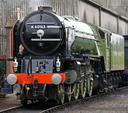Antiquarian Engineering: Drafting & Drawing. Parts Symboling Systems. Measurement. History of Technology (esp. Dimensioning and Interchangeable Manufacture). On the Reverse Engineering of Big Old Machines.
Workshop Topics: [Optics & Photography.] [Safety.] [Solvents; Basic Hydrocarbon Chemistry.] Lubricants and Coolants. [Power for Workshop Machinery.] [link to Cutting Tool Geometry.] What Is It Called? [Workshops.]
Research Tools. Research Sources and Artificer's Resources. Presentation Conventions.
Also, alas: Computer Programming.
Abrasives. [Ceramics and Crucibles.] [Plaster.] [Smelting Metals.] Lubricants and Coolants. Plastics. [Chemistry.] Formed and Component Materials.
[Metal Smelting & Archeometallurgy.] [Metal Casting.] Metal Smithing. Fitting & Mechanics. [Soldering, Brazing, and Welding.] Machining. Sheet Metal / Conduit. [Electrical Work.]
Typefounding & Lettering & Printing (including The CircuitousRoot Typefoundry and Press).
Telegraphy (except the Teletypesetter, which is covered in the Typefoundry).
Geometric Mechanisms. Construction Toys. Mechanical Breadboard Systems.
[Model Engineering.] [Steam Engines (& Related).] Electrical Components. Horology. Jewelry. [Rail.] [Sculpture.] [On Divers Arts.]

The Past and the Future
The Conservation of Machines and Minds: with special consideration of production machinery
This set of Notebooks is a central point for coordinating various studies scattered throughout CircuitousRoot which deal with the conservation and restorative conservation of historic machinery (both at theoretical and hands-on levels), the reverse engineering of big old machines and reconstructing the minds of their creators (again, both theoretically and in practical detail), and a new situation: the need for the continuation of historic products which are highly important for our culture when the making of those products is closely tied to specific production machinery which is of significant historic value in its own right - especially when that machinery is rare, difficult to conserve, difficult to operate, and past the end of its regular productive life.
1. (Especially with regard to the Notebooks on conservation of machinery in "The Past and the Future") I am not professionally qualified in the field of conservation of artifacts. In any case of an artifact of historic value, nothing here should be acted upon without prior consultation of a qualified conservation professional. I'm just an amateur tinkering in my barn.
2. The writings here are NOT instructional material. They are not intended to teach, and I do not suggest that you do any of the things I write about. I can't stop you if you should choose to do so, but if you do, you bear full responsibility for your actions, and I disclaim all responsibility for your actions. In addition to these legal disclaimers, please see my short essay On Notebooks and Technical Autobiography " for a discussion of what these "Notebooks" really are.
All portions of this document not noted otherwise are Copyright © 2006-2022 by David M. MacMillan.
Circuitous Root is a Registered Trademark of David M. MacMillan.
This work is licensed under the Creative Commons "Attribution - ShareAlike" license, version 4.0 International. See http://creativecommons.org/licenses/by-sa/4.0/ for its terms.
Presented originally by Circuitous Root®